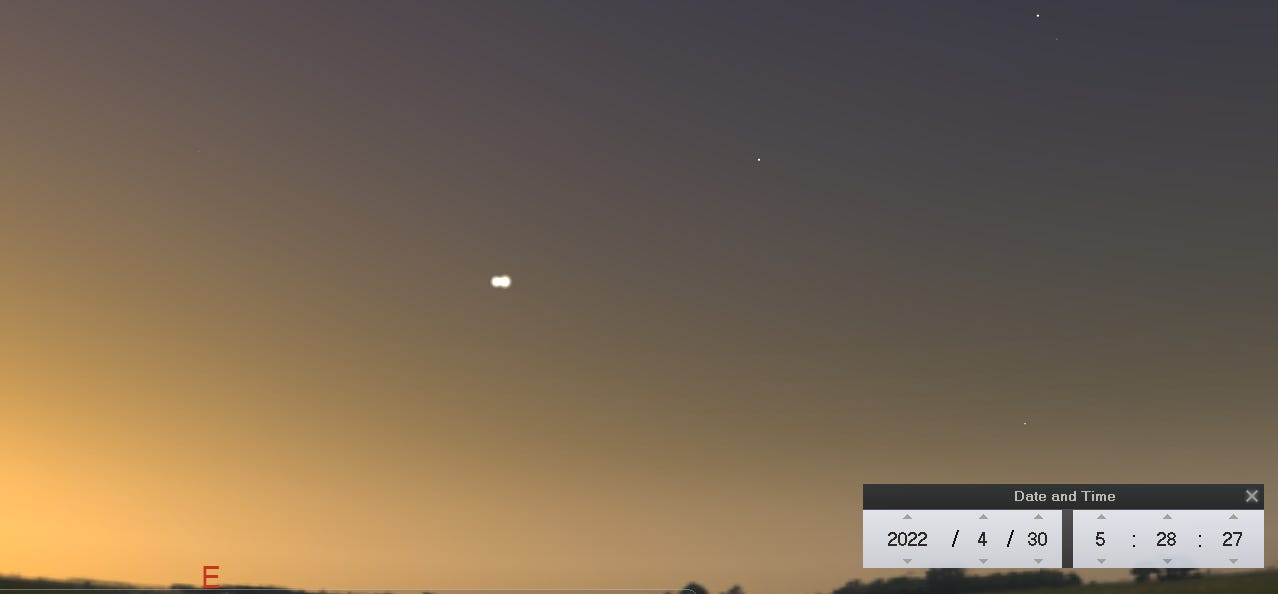The Galactic Times Newsletter #22 - April 16, 2022
Military Admits---It's an Interstellar Meteor <3 years later>, New Way to Make a Jupiter; Mercury Lights Up the Dark, Moon Greets Dawn Planets; Venus Cozies With TWO Gas Worlds; A Prophetic Ship.
Cover Photo - A New Way to Make a Jupiter
In This Issue:
Cover Photo — A New Way to Make a Jupiter
Welcome to Issue 22
This Just In —
Um, That Really Wasn’t an Alien Invader After All…
Neptune’s Summer Hot Spot
Recipe for Making a Jupiter…First, You Stir the Pot….Sky Planning Calendar —
* Moon-Gazing - The Moon Says Hi to the Morning Planets One by One
* Observing—Plan-et —
Mercury Meets the Dark (and the Seven Sisters) in the Evening
Venus Cozies Up with TWO Gas Giant Worlds
Lyrids a Moderate Show* Border Crossings
Astronomy in Everyday Life - Porrima, a Star of a Prophetic Ship
Welcome to The Galactic Times Newsletter-Inbox Magazine, #22 !
Click here https://www.thegalactictimes.com for our Home Page, with all past issue Tables of Contents and stories indexed by topic. You can also hear and find useful materials for education from our former podcast, on the website (plus links to other Hermograph products and periodicals).
Head here -
— for our (Free) Subscription Page and subscribe, or to read in the Archive.
If you are enjoying this twice-monthly newsletter, please support it by 1) using the link at the end to spread copies to your colleagues and friends and urge them to subscribe (why should you do all the emailing, right? We’re glad to do it!) and 2) if you are an educator, subscribe to the Classroom Astronomer Inbox Magazine, too!
Thanks!
Publisher — Dr. Larry Krumenaker Email: newsletter@thegalactictimes.com
This Just In—
* Um, That Really Wasn’t an Alien Invader After All…
On Earth it was announced that a third (at least) interstellar visitor has been noticed. The earliest were comets and asteroids, first noticed back to 2017. The latest was a meteor that struck somewhere near Papua New Guinea. It was spotted in NASA’s Center for Near Earth Object Studies database. But then the researcher, then an undergraduate, couldn’t say anything on it because the military, i.e. the US Space Command, wouldn’t actually confirm or deny the speed or orbital characteristics of the object for three years, as the database is now under their control. Now the data has come out…to the researcher’s total surprise, having moved on…..<sigh>
* Neptune’s Summer Hot Spot
All planets have seasons, some more dramatic than others. Mars’ lasts twice as long as Earth’s. Uranus’ are super extreme, since for a quarter of its 84-year orbit one pole points directly at the Sun, another quarter has the other pole sunward, and the remaining half has neither pole facing the Sun. Neptune isn’t too much different from Earth…tilt-wise. We’re 23-degrees, it is 28. But at around 30 Astronomical Units (AU) [we’re…1] all the seasons are, well, wintry-cold. So why did Neptune’s polar atmosphere just do a 20 degree warm-up while the whole planet is cooling down? Yes, one would expect a summer warming (such as it could be on such a distant world) but with summer lasting 40 years, why 20 degrees in 2 years, and just there? Is it a sunspot related warming? Something in the (Neptunian) air? No one knows yet. But it shows up as a brightening of the clouds at Neptune’s South Pole in photos.
* Recipe for Making a Jupiter…First, You Stir the Pot….
Speaking of Gas Giant worlds, our Jupiter is a mere 5 AUs from the Sun. It, and the other gas giants, is believed to have formed from the absorption of lots of little baby worlds—planetesimals—that hadn’t had time to form into Earths. But the vast majority of exoplanets found have been exo-Jovians, and larger, and farther away than any gas giants we have. Like 50 or 100 AUs out. Way too far to have a steady diet of planetesimals to grow on. Where did they come from?
The research team used archive data from the Hubble Space Telescope to investigate a 9-times-Jupiter-sized exo-planet around a young star AB Aurigae more than 70 AUs out from its star. The images show it buried in a spiraling mass of nebulosity (see Cover Photo), supporting a hypothesis that gas giants can form far out from a star not by absorbing other little baby worlds but by condensing out of the nebula the star is in, through disk instability.
Sky Planning Calendar
Moon-Gazing
Moon passages by a star, planet or deep sky object are a good way to find a planet or other object if you’ve never located it before.
April 16 Full Moon.
April 19 Perigee. The biggest Moon of April—A Super-Waning-Gibbous-Moon—occurs while it is transiting the head of Scorpius the Scorpion. See its red heart Antares to the Moon’s lower left.
April 23 Last Quarter Moon.
April 24 Now the Moon leads us into the parade of morning planets! First up, this morning finds Saturn 5-degrees (upper left) of the Moon. Then, 24 hours later …
April 25 …Mars is a bit closer, 4-degrees to the Moon’s upper left. Two days later, though, the thinning crescent Moon makes the most photogenic passages….
April 27 …First, the Moon passes 4-degrees south of brilliant Venus and six hours later it is does the same with Jupiter. Which one is closest for you depends on your geography but no matter where you are you’ll have a beautiful sight to see or photograph! And for those with a telescope, Venus passes REALLY close to Neptune (see below).
April 30 A rare thing for a fortnite, three phases to mention. Today, New Moon, and the ultimate conjunction, but not for most TGT Readers….the Moon is visible only if you are in southern South America….at sunset…when it passes in front of the Sun in a partial eclipse. Best for viewers in Chile, and Argentina and for a few lucky ones in Bolivia, Paraguay, Uruguay and some extreme edges of Antarctica, you’ll see a Sun with a bite out of it, as much as about half a Sun missing, as it sets.
Observing---Plan-et….
In addition to the Moon sliding past Saturn, Mars, Venus and Jupiter in the dawn, we have three other interesting solar system events this second half of April!
Evening has Mercury and it provides a very fine show! First, as an appetizer, on the 18th, telescope observers can use Mercury as a guide to giant Uranus, 2-degrees to Mercury’s lower-left. Then, it reaches a maximum distance from the Sun so great that it will set after evening twilight ends starting the 21st, actually visible for as long as 15 minutes, low but in darkness, and into early May. Its maximum elongation is on the 28th, but the two days before that it makes a pretty picture 1.5-degrees or about with the Seven Sisters (Pleiades) star cluster.
In the middle of the nights of the 21-22 and 22-23, the drought ends, with the first of the spring showers. Meteor showers, that is. The Lyrids, radiating out of the summer constellation of Lyra the Harp, aren’t very stormy, only a max of 20/hour. That would happen if Lyra were overhead and the sky was dark, but not this year. You’ve got a bright gibbous moon rising shortly after Lyra does so your best views will be over circa 2 or 3 AM, respectively, those nights. Look 60-degrees or more away from the Northeast, where Lyra is rising, to see the Lyrids from their sides, for the best views, not AT Lyra!
There are two other very close conjunctions of planets! On the 27th, as noted above, Venus passes 0.01-degrees South of distant Neptune (in the USA, that conjunction happens at midday so you’ll see Venus only 0.4-degrees away in dawn, still an awesomely close conjunction). Most impressive will be the last day of the month’s conjunction of Venus and Jupiter, the two brightest planets. In the USA, you’d just barely fit the Moon (busy eclipsing the Sun, though) between them, 0.5-degrees apart, but over the Pacific you’ll see the two worlds separated 0.2-degrees.
Border Crossings
The Sun enters Aries on April 19th which is a good thing because if it entered Taurus on the 20th, as the usual horoscopes say it would, we wouldn’t get to see Mercury near the Pleiades on the 26th, now would we?
Astronomy in Everyday Life
Porrima - A Prophetic Star of a Ship
Amateur astronomers may know the name Porrima as that of a beautiful binary star in the constellation of Virgo, which rises early in the evening now. Also known as Gamma Virginis, it is two nearly identical yellow-white stars orbiting a common center of mass, tight but resolvable in medium-sized telescopes that can resolve stars less than an arc-second apart. In earlier decades, it was easier, even department star Christmas refractors could split it — yours truly has logbook drawings of the pair from the 1960s seen through a 2.4-inch refractor — but the stars have moved much closer together during this part of its 168-year orbital period. It is one of the brightest and closest of binaries, a mere 38-39 light-years away. Despite being the Gamma star—which should mean it is the third brightest star of Virgo—it is actually the second brightest, at magnitude 2.7; the Beta star to its west is nearly a full magnitude fainter!
Porrima was a Roman god of prophecy and often associated with predictions related to childbirths.
Porrima is also the name of an interesting new ship featured in a recent CNN article that could be the birth of a prophetic kind of maritime enterprise.
Its roof is an overhang of solar cells providing most of the power for the 118-foot long, 79-foot wide ship, including propulsion. The rest will be provided by recycling nanoplastics it filters from seawater, from which it produces hydrogen for hydrogen fuel.
Currently engaged in a round-the-Earth demonstration voyage, making stops on five continents, its technologies are nevertheless being already added to some fleets and vessels.
You can read the article for yourself at www.cnn.com .
Thanks for reading The Galactic Times Newsletter! If you haven’t already, subscribe for free to receive new posts.
Spread the word and get others to sign up!
Articles for The Galactic Times Newsletter are welcome. Query us at the email address below!
You can help support this publication by also subscribing to The Classroom Astronomer, and by purchasing other books or products from The Galactic Times’ parent company Hermograph Press. Click below to head to Hermograph’s home page:












